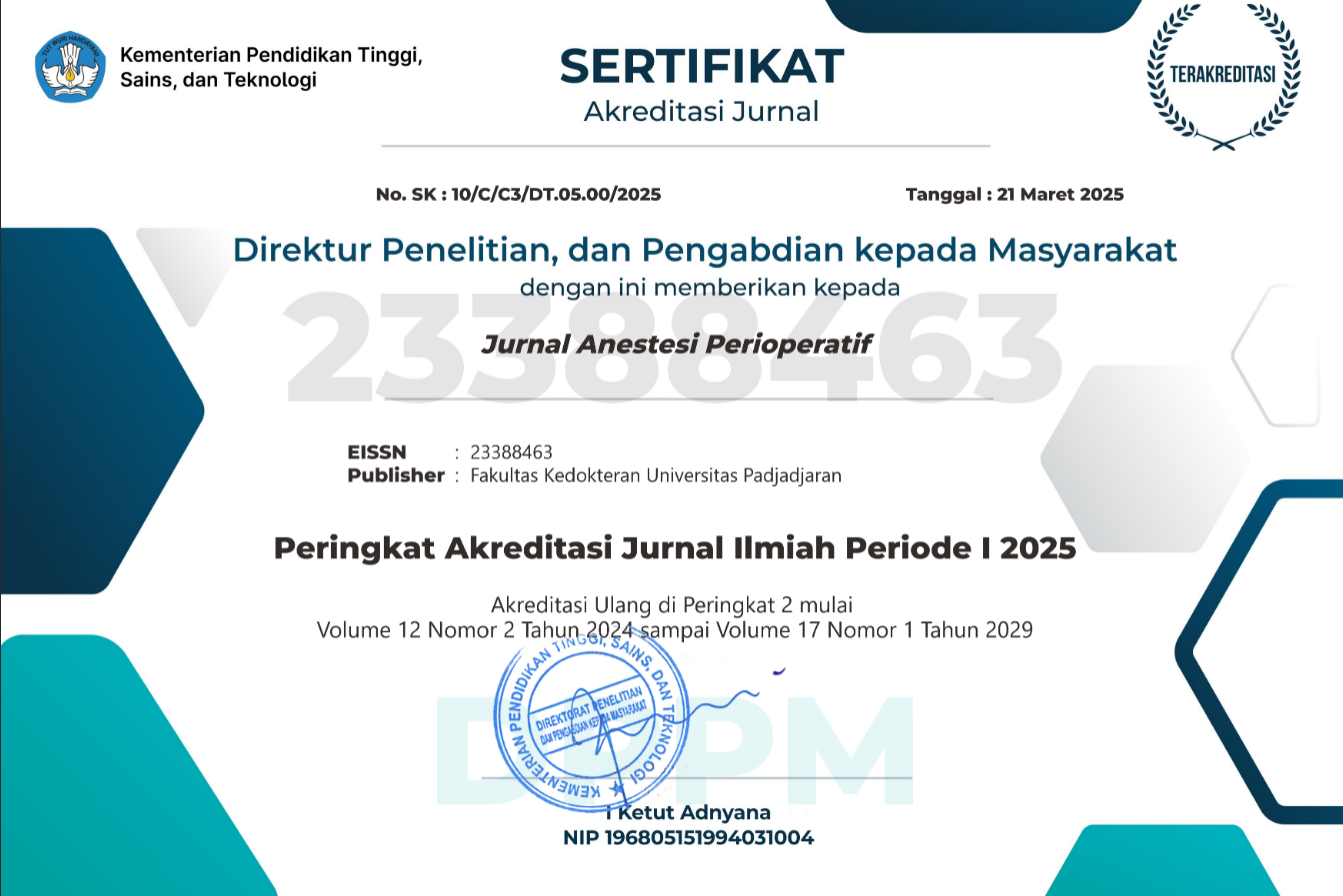Perbandingan Waktu Awitan dan Lama Kerja Kombinasi Bupivakain 0,5% dan Lidokain 2% dengan Bupivakain 0,5% pada Blokade Infraklavikular untuk Operasi Lengan Bawah
Abstract
Penggunaan kombinasi obat anestesi lokal bupivakain dan lidokain dapat menghasilkan waktu awitan yang cepat dan lama kerja yang panjang. Penelitian ini bertujuan membandingkan waktu awitan dan lama kerja kombinasi bupivakain 0,5% dan lidokain 2% dengan bupivakain 0,5% pada blokade infraklavikular untuk pembedahan lengan bawah. Penelitian menggunakan uji klinis acak terkontrol buta ganda terhadap 36 pasien dewasa usia 18–60 tahun yang menjalani pembedahan lengan bawah dan dilakukan blokade infraklavikular dengan panduan nerve stimulator di Rumah Sakit Dr. Hasan Sadikin Bandung selama periode April–Juni 2015. Pasien dibagi dalam dua kelompok, kelompok bupivakain dan lidokain (BL) dan bupivakain (B). Analisis stastistik menggunakan student’s t-test, chi-square, Eksak Fisher, Kolmogorov Smirnov dan Mann-Whitney U-test. Hasil penelitian didapatkan waktu awitan blokade sensorik dan motorik pada kelompok BL, yaitu 7,1±2 menit dan 10,9±5,3 menit, pada kelompok B, yaitu 19,8±4,5 menit dan 29±7,7 menit. Lama kerja blokade sensorik dan motorik pada kelompok BL, yaitu 540,9±195,1 menit dan 445,6±158,9 menit, pada kelompok B, yaitu 837,6±376,6 menit dan 653,9±304,3 menit. Simpulan, kombinasi bupivakain 0,5% dan lidokain 2% menghasilkan awitan blokade sensorik serta motorik lebih cepat dan lama kerja yang lebih singkat dibanding dengan bupivakain 0,5%.
Kata kunci: Blokade infraklavikular, kombinasi bupivakain-lidokain, bupivakain, lama kerja blokade, waktu awitan blokade
Comparison of Onset and Duration of Action between 0.5% Bupivacaine and 2% Lidocaine Combination and 0.5% Bupivacaine on Infraclavicular Block for Forearm Surgery
Abstract
The combination of local anesthetic drugs bupivacaine and lidocaine can produce rapid onset and long duration of action. The purpose of this study was to compare the onset and duration of action between 0.5% bupivacaine and 2% lidocaine combination and 0.5% bupivacaine on infraclavicular block for forearm surgery. This study was conducted using a randomized double blind controlled clinical trial on 36 adult patients aged 18–60 years who underwent forearm surgery under infraclavicular block using nerve stimulator guidance in Dr. Hasan Sadikin General Hospital between the period of April to June 2015. Patients were divided into two groups: patients in bupivacaine and lidocaine (BL) group and bupivacaine (B)group. The statistical analysis were performed using the student’s t-test, chi-square, Fisher’s Exact, Kolmogorov Smirnov, and Mann-Whitney U-test. The onsets of sensory and motor blocks in BL group were 7.1±2 min and 10.9±5.3 min, repectively and B group were 19.8±4.5 min and 29±7.7 min, respectively. The durations of sensory and motor blocks in BL group were 540.9±195.1 min and 445.6±158.9 min and B group were 837.6±376.6 min and 653.9±304.3 min. This study reveals that the combination of 0.5% bupivacaine and 2% lidocaine in infraclavikular block had a faster onset of sensory and motor blocks compared to 0.5% bupivacaine and a shorter duration of action compared to 0.5% bupivacaine.
Key words: Bupivacaine, combination of bupivacaine–lidocain, duration of block, infraclavicular block, onset of block
DOI: 10.15851/jap.v4n3.902
Keywords
Full Text:
PDFArticle Metrics
Abstract view : 2560 timesPDF - 4854 times
This Journal indexed by

JAP is licensed under a Creative Commons Attribution-NonCommercial 4.0 International License
View My Stats



